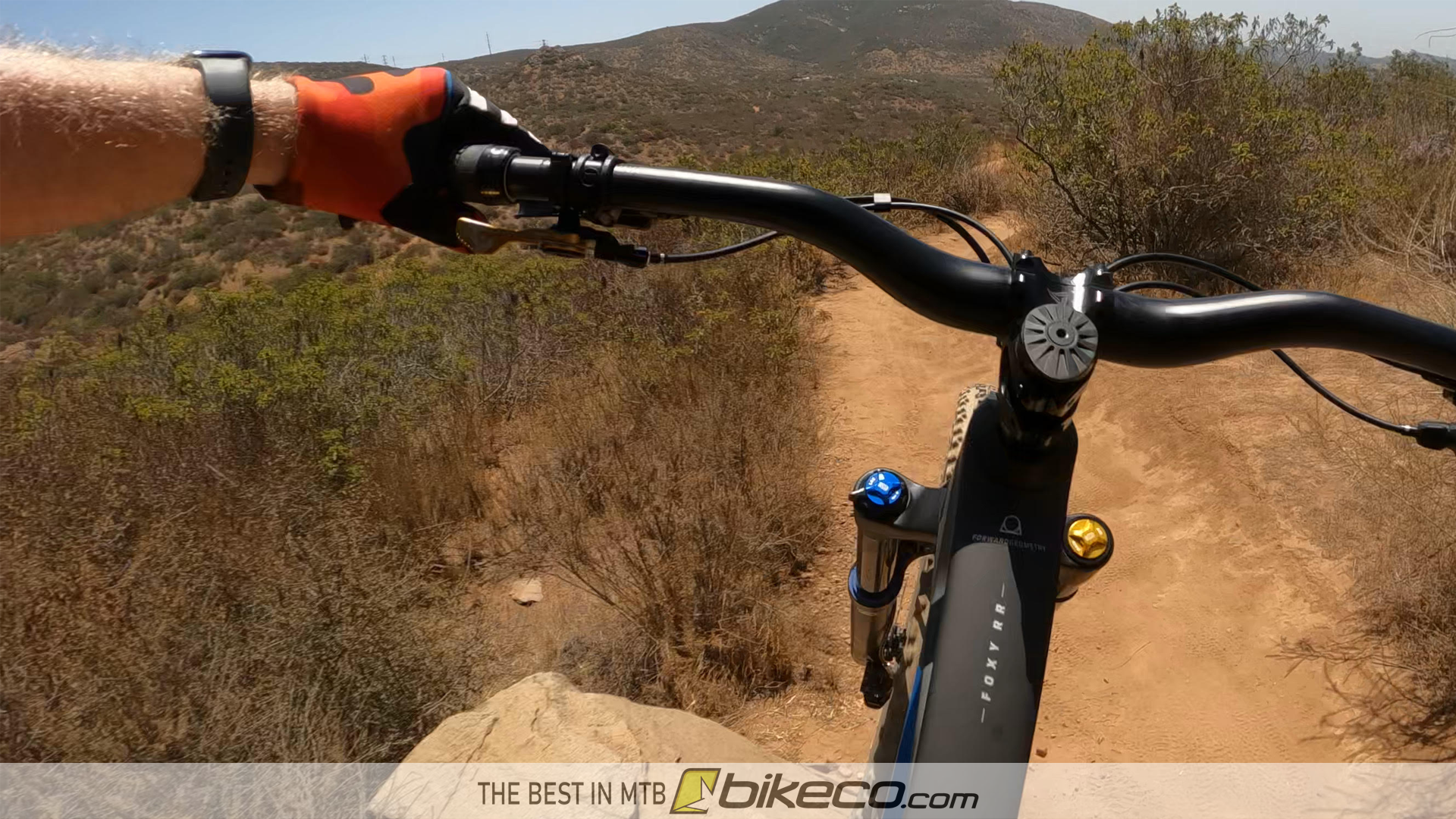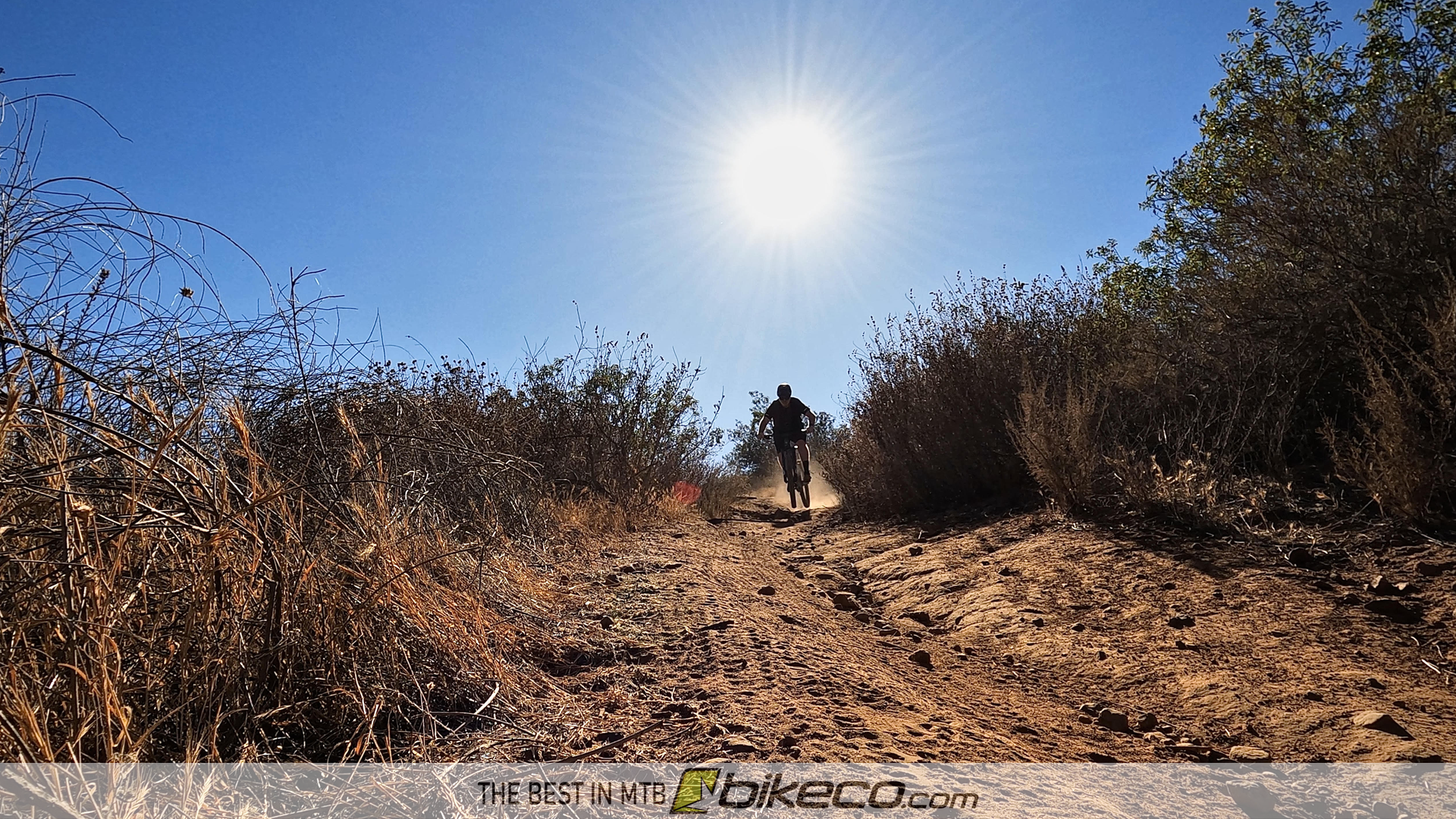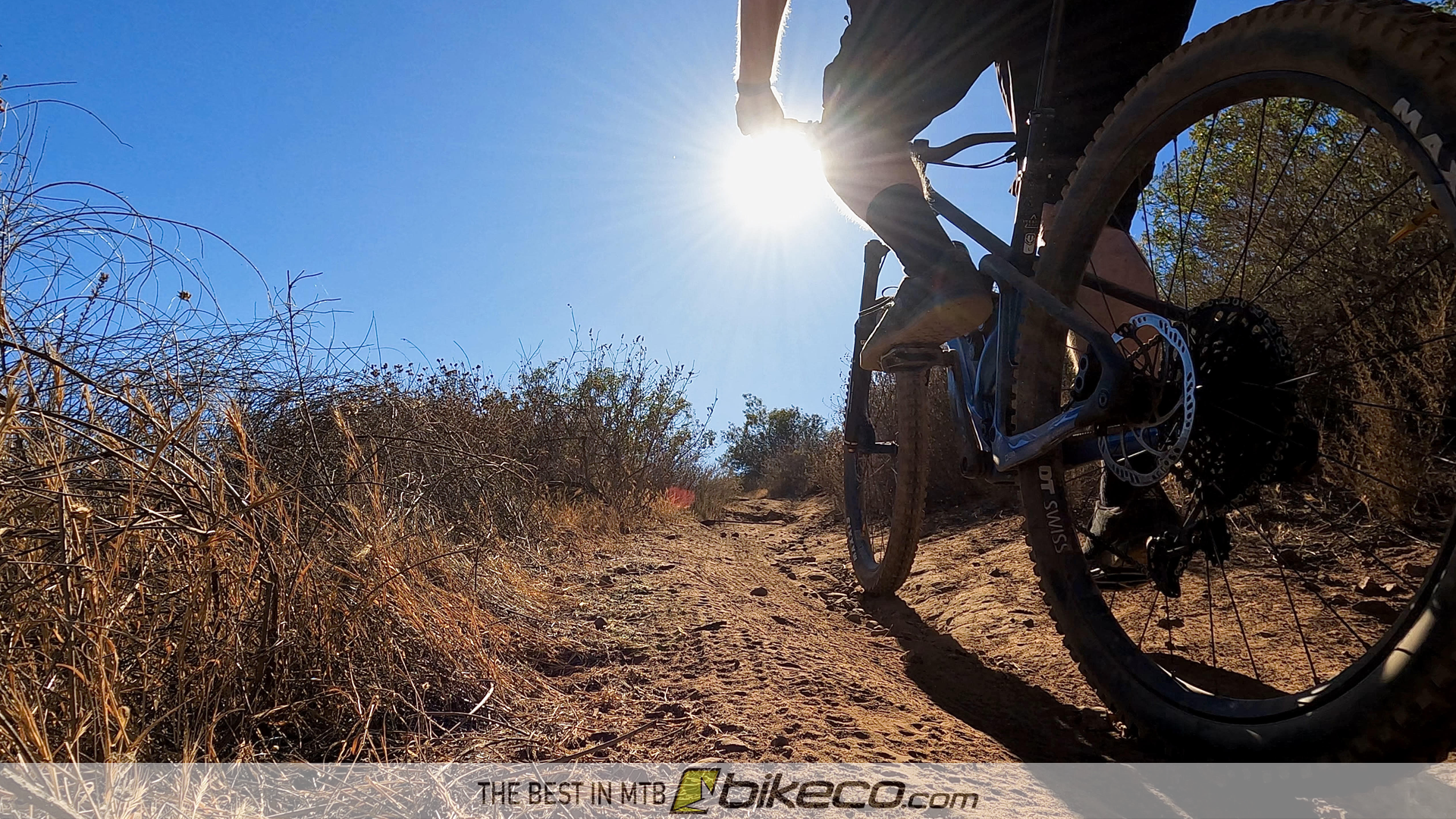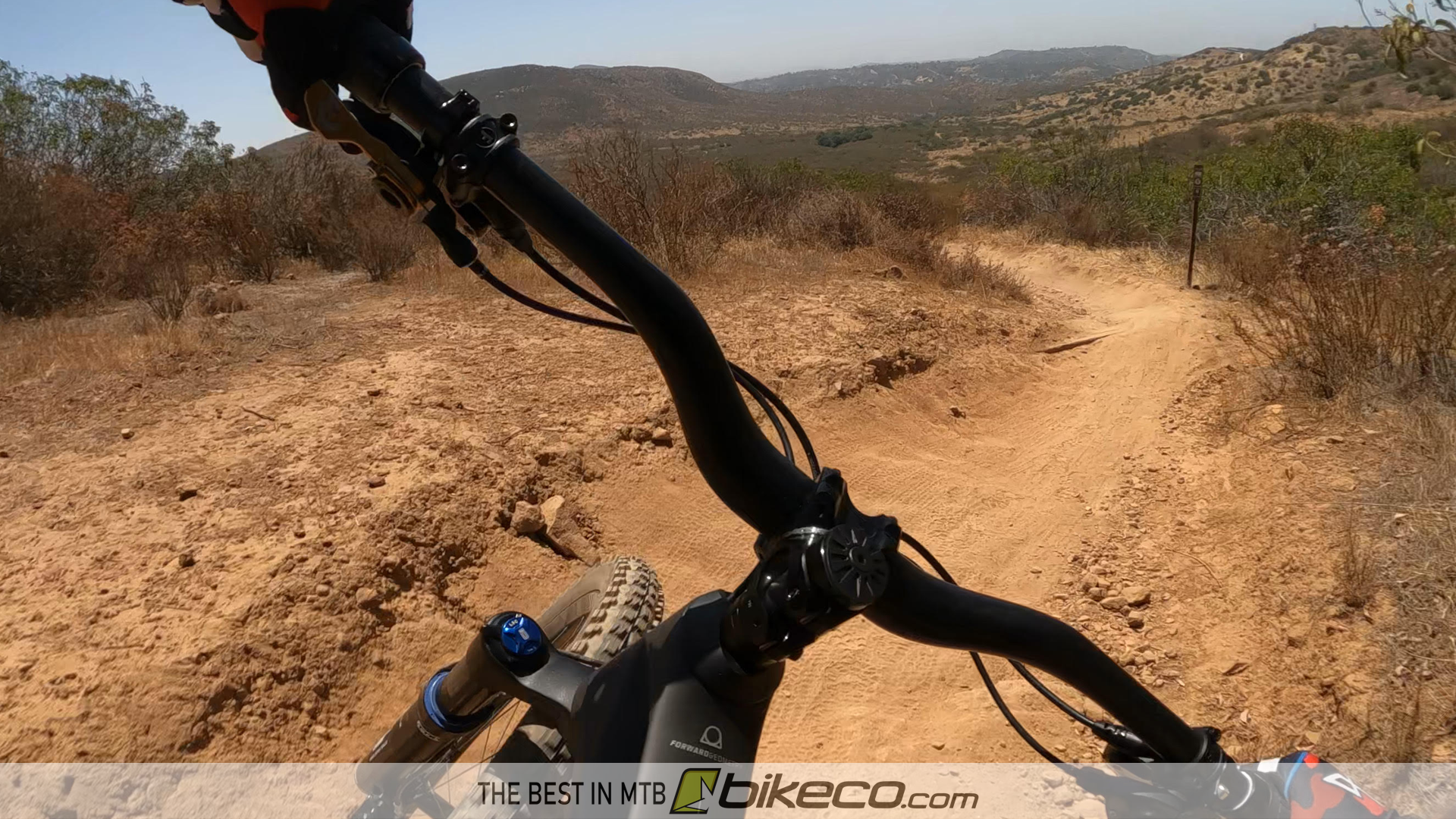
Well, after about 4 years I changed bikes this week. I demo-ed the aluminum Mondraker FOXY and decided the carbon version, with suspension and brakes I liked would be a good fit. So far, I’ve been blown away with how right that is. Here we go with an Extended First Ride: Mondraker FOXY Carbon Review.
To start, if you want to learn a more about the spec of my build you can link over to a post which details some of the “whys” each part ended up on my personal bike.
As a note, I purchase all my product. You can see where I see value. Great performance on budget bits (like Magura MT5 brakes – love em, they work great and they save $) means I have more budget on parts I’m willing to go all in for performance (suspension for example).

What’s an Extended First Ride?
Sounds a corporate-ese right?
This Mondraker FOXY review isn’t a two hour spin and then onto something else. Getting miles in different terrain over a few days allows minor adjustments and a much better understanding of the bikes finite details.
Mondraker FOXY Carbon Review
I’ll go over quick pre-ride notes, thoughts on the trail performance as well as some product specific insight on bits that are new to me on a personal or extended test bike.
FOXY, Before the Ride
Mondraker Fit: Forward Geometry
I wanted to go a little longer than my previous SB130 (Large). Since the FOXY has a longer reach and slightly taller stack per size I stayed in the Large, but it hit my goal of being slightly longer.
Between the stem stack and 40mm bars I was able to get my hands up a bit more which I’m hoping will help my lower back on long or technical climbs.
I centered the saddle on the rails and haven’t changed it yet. It’s a comfortable position even with long legs for my height.
I don’t do a lot of cockpit fine tuning as I need my hands into a pretty specific area to help my lower back uphill. I’ll accommodate as needed downhill to make sure I feel as good as possible uphill… Like my grandma said, getting old isn’t for sissies.
Ohlins Suspension Setup
My first ride was chasing the sun. Luckily, Ohlins has pretty good setup data available. I grabbed their settings and headed off.
The rear shock felt close. Maybe one click here and one click there on the first day to feel the difference.
In the front, the RXF M.2 fork is plush. It felt a bit linear as I prefer more ramp and support so I ended up cranking as much compression into it as possible on the first ride.

On Trail
Riding within your limits is important. Even more on a bike that you are unfamiliar with. I kept the bike well within my ability since my first ride was at dusk and alone.
My first lap was an easy loop near work in Whiting Ranch. It’s a flowy, fun network, close enough to the shop I can ride before or after the day easily. Nothing burly. Prior to my earlier demo ride I was a little nervous that the FOXY would feel “big” or “numb” there. The aluminum demo bike felt OK there so I surmised that the carbon bike with better suspension would improve that. It did.
Since it’s a common lap it’s easy to look for a particular setup window: I want the bike to have traction into the corners and pop out. Rear suspension should be lively enough to pump the trail with notable effect, ie speed increase. Similarly, the fork should have enough support to keep the bike changing direction or floating over terrain and not “diving into” pockets on corners or when the trail comes back up from a hole.
The FOXY’s rear end felt close off the bat. It lacked a touch of support and sat a little deep into the direction changes, but, for a first ride it was well within an expected performance range. Where it gave up a little in support the traction was amazing.
The 36 RXF fork was more linear that I liked, kind of right on the edge of the range of ‘ya, I can get this fixed’. But I knew the Ohlins was going to have a more linear feel and it was a first drop. So, nothing to worry about just yet.
While the bike wasn’t quite as lively as I would consider perfect I wasn’t worried about getting it into the range. The combination of compression controls, ramp up chamber in the fork and volume spacers in the rear shock gave me options to fine tune the pop on the bike.
One thing I took clearly from the first ride on the FOXY: the extra grip was notable. This is one planted bike. More than once where the FOXY held a tighter line than I expected and I ended up handlebars, arms and one time maybe face into the bushes on the inside of a corner.
I was most pleased with how lively the 150mm travel Zero Suspension rides. I had some reservations that the RAZE was a bike I would like better with slightly less travel. Not all of my rides need the FOXY’s full travel, but it’s a lively bike and lets me keep something in the tank for bigger days.
When I demo’d the FOXY I found it climbed much better than I forecast. Even the aluminum demo felt good downhill. The carbon FOXY, with brakes that I had faith in and suspension with more compression support would take the ride to the next level. And it did.
Extending the First Ride Review
Writing on a single ride admittedly creates a situation where you have to extrapolate some data based on previous experience rather than actual product experience. To have a more substantial and credible post I wanted a few more rides on the FOXY.
My next ride was in Mission Trails in San Diego. This is a park not too far from my house. A little steeper and burlier terrain in parts than Whiting, but its still a fun ‘by yourself’ pedal. BTW, I don’t see a reason to test in conditions that push you to the point you can’t really understand what’s happening, like if my first ride was in the burliest terrain I can handle what am I going to write competently?

Climbing the Mondraker FOXY
As always, I have to disclaim this: I am not a good climber. Not my forte nor my priority. So, most of you can out climb me. I get uphill to ride down – and as long as I eventually get up there I’m quite pleased hahaha…
What am I looking for when climbing for a competent write-up? Traction and acceleration. Those two things I can feel and translate to other riders. As far as churning your legs faster and further? You got that I’m sure!
Mission Trails offers sections to feel how a bike tracks around switchbacks, handles loose rocks and gets over protruding rocks.
Switchbacks
The Mondraker tracked pretty well, around even tight switchbacks. I was intrigued to see how the slacker headtube angle compared to my previous SB130 TLR would behave. Pretty close, and without the four years of experience on the bike too…
On the tightest radius corners I found myself letting the front end get light and driving around off the back wheel. Concentrating and keeping the rear wheel under power when I get tired is difficult. I tend to just bash things and stay under power. A stronger rider likely would kind of half stand to pedal and push the front end down around the corner. The survival pedal-er, me, needs to keep the momentum going or the pedals stop and it’s foot down. This leads to staying in a more singular position and letting the front end go light and kind of body-englishing it around. Something I could work on for sure. Bike is more competent than me in this situation.
I’ll touch again on climbing switchbacks a bit later.
Climbing Rocks and Baby Heads
The FOXY climbed very sure footed in loose rocks. Zero Suspension didn’t suffer wheel spin even as the rocks moved under the power.
It behaved even better in the larger protruding rock sections. During a test ride I try to use a combination of lines that I know as well as off-line bizarre routes to see if the bike wants to behave or not. In both scenarios the FOXY was extremely competent and predictable.
One of the most notable things, the Mondraker, being so sure footed, keeps the rear tire in line very well. Compared to bikes that can lose the read end under power and kind of fish-tail around the Mondraker overall kept its heading well. This is beneficial as it requires less body-english to keep the bike moving forward.
My favorite aspect climbing was how the bike feels like it ‘crawls’ up rocks.
Previous bikes I’ve had seem to push ‘back’ when approaching some of the lines in Mission Trails. As an example, you’d almost have to pedal into the section, start up the rocks, the suspension would come back and as a rider you’d push the bike back forward to continue. It takes much more energy and thought (two things I might not have a lot of climbing admittedly).
The FOXY seems to ‘crawl’ up the rock rather than pushing back. Much more of the momentum is retained in a forward direction which is a confident feel. It’s notable how well a 150mm rear travel bike climbs these days – man it’s come a long way from when I started riding…
Acceleration
OK, while not a climber, I’m a strong enough to tell how a bike accelerates. I then extrapolate this into efficiency a bit.
The Mondraker accelerates really well whether pedaling seated or standing. When you increase the wattage to the cranks the bike quickly responds.
This compares favorably against bikes that feel like when you start putting a ton of power they take a second to load the suspension then start spinning the wheel a bit more. The FOXY rewards the effort quickly and crisply.
The bike accelerates quickly and it feels appropriate to the amount of increase of power to the increase of ground speed.

Mondraker FOXY Downhill Performance
Well, here’s where it gets fun. Like real fun.
The FOXY is a blast downhill.
It corners well, it handles chunk, it has a personality that is snappy enough for me but isn’t so fast handling that it will give you issues if you push it a bit past your skill level.
Cornering
This is a very planted bike. As such braking performance is great.
Jump on the brakes hard and roll off them before a corner you’ll find the FOXY slows well and then resets to track excellent into the turn. It is quick to change direction and confident accepting lean angle both early and in the middle of the corner.
Four rides in and I found the limit of how much rear compression I like, where the bike starts to chatter just a bit in the mid corner at speed. Now I’m dialing back to get a bit more grip in the mid and corner exit.
I started with stock volume spacing and ran the suggested air pressure and close to the compression and rebound settings. Having found the limit with the compression and PSI my next step will be to go back with volume spacers and see if adding some support through air ramp allows me to back off the compression a bit.
Frankly, in a short time I’ve gotten very comfortable with the FOXY’s cornering.
At first the added grip even had me running too tight, into bushes on the inside of corners once or twice! After a couple instances I thought the bike might have pushed out of a corner – but going back and glancing at footage it might be that the additional grip has lead to an increase in cornering speed. (not even riding at full tilt! Impressive)
Finally on cornering: after each ride I note the bike’s condition with particular interest to travel used and whether the tires have any tell-tale markings on the sidewalls. I have yet to get any of the slashes on the sidewall, so I have a little more traction and compliance left in the tires if I want it as well.
Improving the bike in the corners
I’m still working to get a bit more support out of the front end which I believe will give the bike even a touch more speed out of corner pockets. A lot of this comes back to my riding size and ground speed combo.
While the Ohlins fork is a bit linear for me, a heavier rider on the max end of the air pressure, for the average 160-220lb rider I would say that the fork setup is much easier. The performance window allows for a more precise setup feel and wider range of options. Particularly using the ramp up chamber at a higher pressure per weight.
I’m working on some setup with it and it’s not so far out of the window that its unusable by any stretch. I suspect that I’ll find some magic in it. If I don’t I’ll go back to a FOX 36 or 38 GRIP2.
It’s the mid support that I’m working through at the minute.
The fork is plush, which I could give up some for more support, but I’m trying ride a normalized sag setting at the moment. I may increase the PSI and look for maybe 15-18% sag but I’m still playing with other options before I get too far away from the 20% sag.
The Ohlins high speed compression works well. I cranked it up a couple rides and it kept me out of the final bit of travel. I’ve backed it down a bit as it wasn’t adding as much to the mid stroke as I wanted and was costing me that last bit of travel in a couple situations that might have warranted it.
Personally I’m just looking for a little more right as the bike starts to set into the travel. I feel like its there and I feel like I’ll find it. Or I’ll keep pestering Joe until he goes into it and I get the first Ohlins Pro Tune…
Speaking of the fork let’s look at some terrain that needs more fork.
Chunky Terrain
The quick take: Mondraker’s FOXY is predictable and at home in chunky terrain.
The FOXY’s sure-footed personality glows when you point the bike downhill. Even running on the far end of ‘poppy’ compression the bike sticks to the ground. Since it’s hard to push the bike to a point of skipping across the trail both turning and braking capacity are excellent.
Looking at my notes, the only complaints have been based the feeling like I’ve run deeper into the front travel than I prefer, but the fork hits the HSC and hasn’t buried. I would just like a little less of that dive in feel.
I’ve bottomed the rear end of the bike a couple times but haven’t felt a hard bottom yet. It has a confident feel through the travel.
Downhill Riding Position
My opinion on the Mondraker’s riding position, given that my setup is a compromise for my back, should be taken with a little bit of a grain of salt.
However, my setup isn’t so far in the weeds that it needs to be disregarded (try to sneak a look at test bike setups sometimes, I don’t know how some of these reviewers even ride ‘em…)
I’ve found the FOXY feels like you’re ‘in’ not ‘on’, which is nice. Front and rear wheel are both relatively easy to control from a standard downhill position. The bike behaves as expected if you move weight fore and aft.
I find I’m riding slightly more nose heavy than my previous rig. This might be one of the reasons I keep coming back to a bit more mid support out of the fork. But there’s also a difference of 4 years versus 4 rides experience. Maybe I’m getting used to it. I’ll have to look at if I’ve raised my hands a notable amount as well.
Slacker Headtube and More Trail
Compared to the 130 LR the FOXY has a slacker headtube, and thus an increase in trail measurement. I was a little fearful that this would numb the front end of the bike on trail and light enduro terrain.
So far, I haven’t noticed that. My continued adjustments have all improved the cornering of the FOXY downhill but none of them are based on a numb feeling.
Uphill in tight switchbacks I think I feel it a little more.
I found two ways to make the FOXY get around the real tight stuff.
Steering with the bars and leaning ‘out’ of the turn to keep the bike standing as straight as possible kept the steering input from wanting to exacerbate the lean angle.
The second option is not steering much at all and really leaning into the uphill corners. This requires more power as it works better at speed.
Both of the above worked. What felt like it didn’t work as well was kind of half turn half lean options. We live in a polarized world – so what should I expect haha…

Wrapping Up the Mondraker FOXY Review
I’m going to try to be concise as I’m edging into 3000 words and all the seo machines are going to hate me… Also I want to have a couple blurbs on some new parts I’m riding and what I think as well below.
The FOXY with a 160mm fork and 150mm of rear travel on paper probably doesn’t look as trail and light enduro friendly as it is. This is an efficient pedaling bike. Mondraker’s well-designed suspension, they’re not using quantity of travel to make up for poor quality of travel like some designs do, means the bike feels fun and poppy throughout the travel. I don’t notice the bike using more travel than it needs nor do I feel the bike being harsh or uncomfortable sitting in the middle of the travel. I suppose what that means, the ramp and compression pairing on the rear shock give a good feeling balance through the travel. Instead of feeling ultra linear even though maybe I’m using 135-140 of the rear travel the bike feels progressive and poppy without becoming teeth rattling harsh in the last bit of rear travel.
Downhill Mondraker’s years on the race course have produced a bike that’s competent and predictable in a wide range of terrain. I didn’t notice any harsh square edge hits and the bike ate up terrain even when I deliberately put it in abusive lines.
For the average rider the Mondraker FOXY’s handling is awesome. The bike’s braking capacity is tremendous allowing confidence at speed. The grip is top of class, again adding confidence. And the bike changes directions quickly and competently.
More to come on this I’m sure, but let me quickly touch on some opinions on new parts to my bike. Starting at the back and going to the front:
10-52t cassette. I’m not a good climber. But, if you are, that 52t is a big jump from the 42t. I think I will end up getting stronger as I find myself in the 42t more often because I’m tepid to shift hard into that big 52t. But, it is a great granny gear!
Small flange diameter DT Swiss 350 hubs. This will be interesting. I’ve run 28h DT Swiss before, but this smaller diameter hub with straight pull spokes will be intriguing. Upside potentially more damping during cornering. The DT internals are top notch – but will the longer spokes cause me any issues? (again, I’m bigger than you!)
AbsoluteBlack Oval Chainring. First thoughts, when you’re going so slow that everything hurts well it hurts the same. If you get up a bit past that pace I can see where the change in leverage does probably make it an easier pedaling system. Since this is the pace I tend to live in I think I will like it overall. If you really start cranking a huge cadence it feels a little strange – but – that’s not been my problem in years…
Ohlins Suspension. See above – more to come on that too.
Fidloc magnetic bottle cage. Interesting. Makes a different noise downhill than I’m used to, but seems to stay in place and has a low profile overall.
New FOX Transfer Seatpost. Love the saddle mounting hardware. Love it.
Tag T1 Carbon 40mm rise bars. Love them so far. I went with them for the height as well as I wanted to try their ovalized internal carbon design to see how that feels on trail.
Ergon GE1 grips. RIP to the WTB Padloc I loved for so many bikes. I picked the Ergon as they had a nice feel on the outside of the top surface where you’re looking offer a bit more squish.
Thanks for the read! Shopping for your dream Mondraker? Want to learn more about the bike or the Ohlins’ Suspension? Check out the links below
Update(s):
Extended Review of the Mondraker FOXY – More Trail Time and Spec Detail
Video/blog: Compare the Ohlins RXF and FOX 38 on Mondraker FOXY Carbon
Images/blog: Extra FOXY, 170mm fork on Mondraker FOXY Carbon with Float X2

